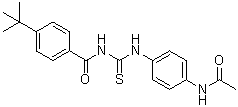Tenovin-1 is a novel and potent activator of p53 that guards against MDM2-mediated p53 degradation. It was discovered by a cell-based screen. It works by preventing SirT1 and SirT2 from deacetylating proteins, increasing levels of the p53 protein, p21CIP/WAF1 protein, and mRNA, and protecting p53 from mdm2-mediated degradation with little effect on p53 synthesis.
Physicochemical Properties
| Molecular Formula | C20H23N3O2S | |
| Molecular Weight | 369.48 | |
| Exact Mass | 369.151 | |
| Elemental Analysis | C, 65.01; H, 6.27; N, 11.37; O, 8.66; S, 8.68 | |
| CAS # | 380315-80-0 | |
| Related CAS # |
|
|
| PubChem CID | 1013376 | |
| Appearance | White to off-white solid powder | |
| Density | 1.238±0.06 g/cm3 (20 ºC 760 Torr) | |
| Index of Refraction | 1.651 | |
| LogP | 2.97 | |
| Hydrogen Bond Donor Count | 3 | |
| Hydrogen Bond Acceptor Count | 3 | |
| Rotatable Bond Count | 4 | |
| Heavy Atom Count | 26 | |
| Complexity | 514 | |
| Defined Atom Stereocenter Count | 0 | |
| SMILES | O=C(NC(NC1=CC=C(NC(C)=O)C=C1)=S)C2=CC=C(C(C)(C)C)C=C2 |
|
| InChi Key | WOWJIWFCOPZFGV-UHFFFAOYSA-N | |
| InChi Code | InChI=1S/C20H23N3O2S/c1-13(24)21-16-9-11-17(12-10-16)22-19(26)23-18(25)14-5-7-15(8-6-14)20(2,3)4/h5-12H,1-4H3,(H,21,24)(H2,22,23,25,26) | |
| Chemical Name | N-[(4-acetamidophenyl)carbamothioyl]-4-tert-butylbenzamide | |
| Synonyms |
|
|
| HS Tariff Code | 2934.99.9001 | |
| Storage |
Powder-20°C 3 years 4°C 2 years In solvent -80°C 6 months -20°C 1 month |
|
| Shipping Condition | Room temperature (This product is stable at ambient temperature for a few days during ordinary shipping and time spent in Customs) |
Biological Activity
| Targets | Sirtuin; MDM-2/p53; DHODH | |||
| ln Vitro | Tenovin-1 is a p53 activator and elevates the amount of p53 protein within 2 hr of treatment. Treatment with tenovin-1 has no effect on the levels of p53 mRNA. With little impact on p53 synthesis, tenovin-1 (10μM) defends p53 from mdm2-mediated degradation. In a panel of tumor cells expressing p53, tenovin-1 inhibits cell growth and triggers apoptosis. Tenovin-1 functions by preventing SirT1 and SirT2, two significant sirtuin family members, from deacetylating proteins. [1] | |||
| ln Vivo | Tenovin-1 inhibits the growth of tumor xenografts derived from BL2, according to early in vivo experiments. [1] | |||
| Cell Assay | Thiazolyl blue tetrazolium bromide (MTT) assay is used to determine cell viability. In 96-well plates, cells are sown. When indicated, they receive a siRNA transfection or 10 μM Tenovin-1 (tnv-1) treatment. MTT solution (0.5 mg/mL) is added after the allotted amount of time has passed. In an extraction buffer (50% dimethylformamide and 20% SDS, pH 4.7) the formazan crystals are dissolved. A SunRise plate reader is used to measure the absorbance (540–690 nm). | |||
| Animal Protocol |
|
|||
| References |
[1]. Discovery, in vivo activity, and mechanism of action of a small-molecule p53 activator. Cancer Cell. 2008;13(5):454-463. [2]. Exploitation of DHODH and p53 activation as therapeutic targets - a case study in polypharmacology [published online ahead of print, 2020 Sep 8]. J Biol Chem. 2020;jbc.RA119.012056. [3]. The sirtuin 1/2 inhibitor tenovin-1 induces a nonlinear apoptosis-inducing factor-dependent cell death in a p53 null Ewing's sarcoma cell line. Invest New Drugs. 2017 Nov 18. [4]. Induction of Nuclear Enlargement and Senescence by Sirtuin Inhibitors in Glioblastoma Cells. Immune Netw. 2016 Jun;16(3):183-8. [5]. Expression of sirtuin 1 and 2 is associated with poor prognosis in non-small cell lung cancer patients. PLoS One. 2015 Apr 27;10(4):e0124670. |
|||
| Additional Infomation | N-[(4-acetamidoanilino)-sulfanylidenemethyl]-4-tert-butylbenzamide is a member of thioureas. |
Solubility Data
| Solubility (In Vitro) |
|
|||
| Solubility (In Vivo) |
Solubility in Formulation 1: ≥ 2.5 mg/mL (6.77 mM) (saturation unknown) in 10% DMSO + 90% (20% SBE-β-CD in Saline) (add these co-solvents sequentially from left to right, and one by one), clear solution. For example, if 1 mL of working solution is to be prepared, you can add 100 μL of 25.0 mg/mL clear DMSO stock solution to 900 μL of 20% SBE-β-CD physiological saline solution and mix evenly. Preparation of 20% SBE-β-CD in Saline (4°C,1 week): Dissolve 2 g SBE-β-CD in 10 mL saline to obtain a clear solution. Solubility in Formulation 2: ≥ 2.5 mg/mL (6.77 mM) (saturation unknown) in 10% DMSO + 90% Corn Oil (add these co-solvents sequentially from left to right, and one by one), clear solution. For example, if 1 mL of working solution is to be prepared, you can add 100 μL of 25.0 mg/mL clear DMSO stock solution to 900 μL of corn oil and mix evenly. Solubility in Formulation 3: 15% Captisol: 15 mg/mL (Please use freshly prepared in vivo formulations for optimal results.) |
| Preparing Stock Solutions | 1 mg | 5 mg | 10 mg | |
| 1 mM | 2.7065 mL | 13.5325 mL | 27.0651 mL | |
| 5 mM | 0.5413 mL | 2.7065 mL | 5.4130 mL | |
| 10 mM | 0.2707 mL | 1.3533 mL | 2.7065 mL |
